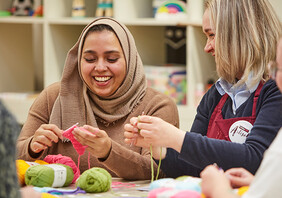Get Started In Candle Making
Personalise scents, colours and styles to create unique candles, tailor-made for yourself or a friend!
Craft your customised candle design, light your wick and enjoy the lovely fragrance and soft glow of your creation!
Handmade candles will also make the perfect gift, ideal for adding to hampers.
Why not get started in candle making with one of our superb workshops?
Get started with the bundle here >
Tool Guide
Get Started In Candle Making
Soya Wax Flakes: Soya wax flakes can be used in a variety of containers as the perfect base for a whole host of different candle designs.
Fragrance Oils: Candles aren’t complete with a beautiful scent! Fragrance oils offer highly concentrated scents that are specially formulated for use in candle making.
Dyes: Highly concentrated candle dye is specially formulated for use in candle making, adding beautiful colour to your wax. Choose the perfect shade!
Wooden Sticks: Craft sticks allow you to position waxed thread to create your candle wick. When balanced over your votive, they’ll hold the wick in position as you add the hot wax.
Pre-Made Wicks: Find the right wick for your handmade candle designs, with pre-made wicks available that are easy to use – perfect for beginners!
Candle Moulds: From pillar candles to small votives, the right candle mould makes it easy to create a beautiful shape.

Try your hand at crafting your very first candle, adding scents and dye to set it apart. Just follow a few simple steps!
Step 1: Create the candle wick by threading the waxed thread through the candle wick base, and secure to bottom of glass candle votive using a glue dot. Wrap the end of the waxed thread around a craft stick until the waxed thread stands upright within the glass candle votive.
Step 2: Melt the soya wax pellets using a double boiler until the melted wax reaches a temperature of 80°C.
Step 3: Add in a small amount of candle dye – ¼ tsp to ½ tsp, depending on desired vibrancy of colour. Mix thoroughly.
Step 4: Add in a small amount of candle fragrance – ½ tsp to 1 tsp, depending on desired strength. Mix thoroughly.
Step 5: Pour the mixture into the candle votive once the wax has cooled to between 50-60°C, ensuring that the craft stick returns to the centre of the votive so that the wick remains straight once the candle sets.
Step 6: Leave the candle on a cooling rack to cool for 24 hours. Then cut the excess wick, leaving roughly 1cm of wick above the top of the candle.








These candles look so beautiful, fresh, and clean, and they smell amazing. They're going to look great in your house!
How to Make Rose and Violet Candles
Fill your home with the essence of romance by making these beautiful soy wax candles that will add a little passion to your mantelpiece.
How to Make DIY Twisted Candles
These twisted candles put a modern twist on a classic décor detail!
How to Make an Air Dry Clay Candle Holder
Bring that warm and cosy atmosphere to your home by creating your own clay candle holders.




Q - Why would you use paraffin wax over soy wax?
Soy wax is a great candle base to use. It gives off less soot than paraffin wax and is 100% natural, and therefore biodegradable. However, when creating candles without containers, such as pillar candles, it is best to use paraffin wax as it has more integrity to stand on its own. The scent-throw of paraffin-based candles is also greater than soy due to the molecular structure of the wax.
Q - Is it safe to microwave paraffin and soy wax?
It is preferential to melt each wax using a double boiler. When this is not possible, you can pop the wax in a microwavable jug and melt on high, mixing regularly to ensure an even melt.
Q - What is the best temperature to pour candles?
The best pouring temperature for soy wax is between 50-60°C. Pillar candles using paraffin wax are best poured at temperatures exceeding 80°C. You can measure the temperature of the wax using a thermometer.
Q - Is it best to heat a glass candle votive before pouring?
Warming a glass candle votive before pouring the melted wax can help to prevent the occurrence of wax ‘frost’ or ‘wet spots’. However, these are simply aesthetic issues and do not affect the functionality of the candle.
Q - How can I avoid tunnelling candles?
It is important for the first burn of any candle to create a complete ‘wet pool’ of melted wax across the entire top portion of the candle – approximately ½ inch in depth. This should usually take two to three hours and usually prevents future tunnelling of the candle. If the ‘wet pool’ does not reach the edges or is extinguishing the flame and the candle begins to tunnel, then the wick thickness is too small for the candle.
Q - Do I need to put instructions on my candles?
It is important to display safety information with a candle – even if you are giving the candle to a friend.















